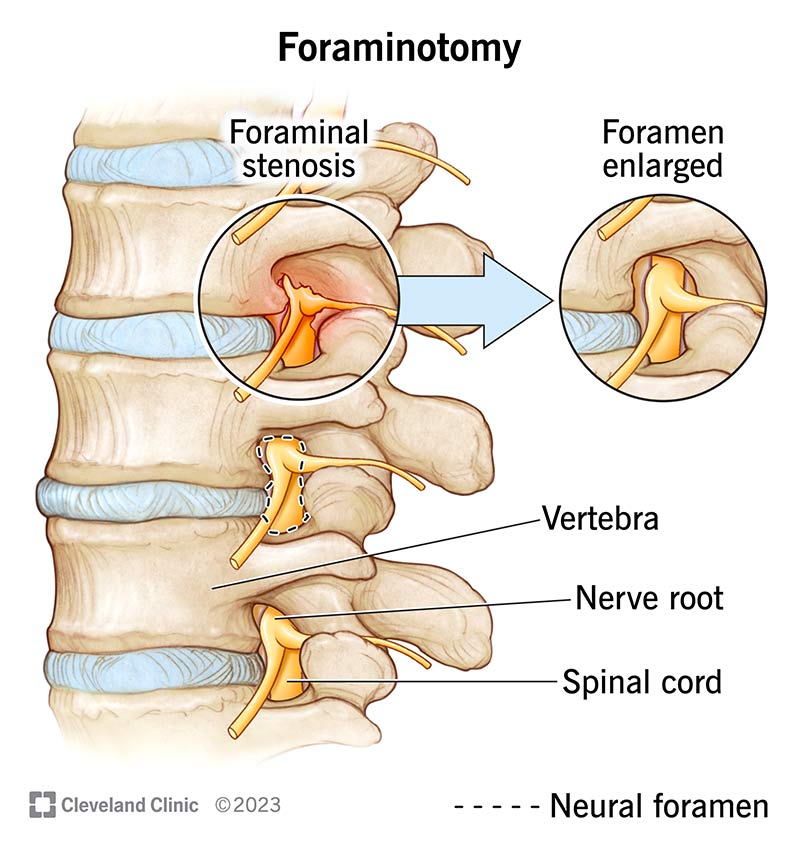A foraminotomy is surgery to widen the foramen, which is the opening of your spine where your nerve roots exit. It treats nerve compression and conditions like spinal stenosis. This safe and effective surgery relieves pain.
Advertisement
Cleveland Clinic is a non-profit academic medical center. Advertising on our site helps support our mission. We do not endorse non-Cleveland Clinic products or services. Policy

A foraminotomy is surgery to relieve pressure on the nerve roots in your spine. This procedure opens up the foramen, or the opening in your vertebra bone where your nerve roots exit your spinal canal (the tube that holds your spinal cord). The nerves that exit your spinal canal through the foramen make up your peripheral nervous system.
Advertisement
Cleveland Clinic is a non-profit academic medical center. Advertising on our site helps support our mission. We do not endorse non-Cleveland Clinic products or services. Policy
If your foramen is narrow, you’ll experience nerve pain and other symptoms that affect your movement. A foraminotomy can relieve this pressure to reduce your pain.
You may hear your surgeon specify the location of your foraminotomy. These are the same procedures, they just happen at different places on your spine:
A foraminotomy treats spinal stenosis. This is the narrowing of space within your spinal canal. Specifically for foraminal stenosis, the neural foramen (the opening in your spinal column where nerve roots leave your spinal canal) is too small. When your nerve roots don’t have the space they need, it causes the following symptoms that can interfere with your daily routine:
Yes, a foraminotomy is a common major surgery. Your surgeon will need to access your spine and they’ll be working next to your spinal cord. There are minimally invasive options for cervical foraminotomy, but it’s still considered a major surgery based on the location. Spine surgeons who specialize in this procedure are highly trained to make this surgery as safe as possible, to reduce side effects and help you feel better.
Advertisement
You’ll meet with a surgeon before a foraminotomy. They’ll perform an exam and review your medical history. They’ll also order imaging tests like an MRI or a CT scan to plan for the procedure.
Let your surgeon know what medications or supplements you currently take, especially if you take blood thinners. They may change the dosage or add a new medication to prevent side effects of surgery. Don’t make changes to your medications unless your healthcare provider approves it.
You should also visit any specialists you see regularly to make sure you’re well enough to undergo surgery; for example, if you have heart disease or diabetes.
Your surgeon may suggest you stop or reduce the use of tobacco products and beverages containing alcohol, which can interfere with how your body heals after surgery.
Also, your surgeon will give you specific instructions on the day of the surgery. This could include not eating or drinking anything for up to 12 hours before the procedure and when and where to go for the surgery.
On the day of the surgery, you’ll receive general anesthesia from an anesthesiologist. This will put you to sleep so you won’t feel pain.
Your surgeon will:
On average, a foraminotomy takes around two hours to complete.
After a foraminotomy, you’ll likely stay overnight in the hospital for observation. When you wake up, your care team will give you medications to ease discomfort. You should be able to sit up about two hours after surgery.
You won’t be able to drive yourself home from the hospital, so you’ll need to ask someone for help. You should be able to drive within one to two weeks following the procedure.
You’ll need to be very careful about your movements after surgery, especially moving your neck if you have a cervical foraminotomy. Your care team will explain what movements are safe and how you can manage your surgical site when you go home. They’ll also give you instructions on how to take care of yourself and who to contact if you have any questions or concerns.
Your surgeon will schedule an exam to check how your body is healing a few weeks after the procedure. You may need to see a physical therapist to exercise and strengthen your muscles.
A foraminotomy relieves nerve pressure. This can improve symptoms like nerve pain, numbness and difficulty moving. It can prevent complications of stenosis like chronic pain.
One study found that, for open and minimally invasive cervical foraminotomies, the success rate was 92% to 94%. Another study found the success rate was 84% to 86%. The success rate measures how well the surgery relieved pain caused by nerve compression two years after the procedure.
Advertisement
Risks of a foraminotomy aren’t common but may include:
Your surgeon will discuss these risks with you before your procedure so you can make an informed decision about your health.
It takes up to a year to completely recover after a foraminotomy. You’ll be able to do light activities four to eight weeks after surgery. Most people go back to work after four to six weeks. Everyone’s body heals differently, so your surgeon will let you know when it’s safe to do certain things like driving, going to work or school, and exercising.
Contact a healthcare provider if you experience any side effects after surgery or concerning symptoms like:
Persistent pain from compressed nerves can interfere with your daily life. Certain movements can hurt worse than others, and your body might not be able to do things you enjoy doing when you have a condition like spinal stenosis. While surgery can be scary, your neurological care team is highly trained to complete this procedure with a positive outcome. If you have any questions about the surgery, don’t hesitate to ask your healthcare provider.
Advertisement
Last reviewed on 09/18/2023.
Learn more about the Health Library and our editorial process.